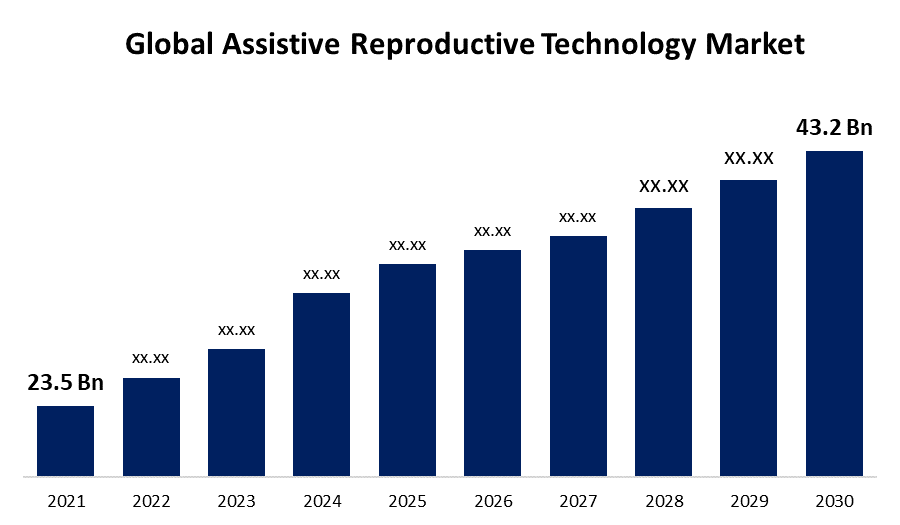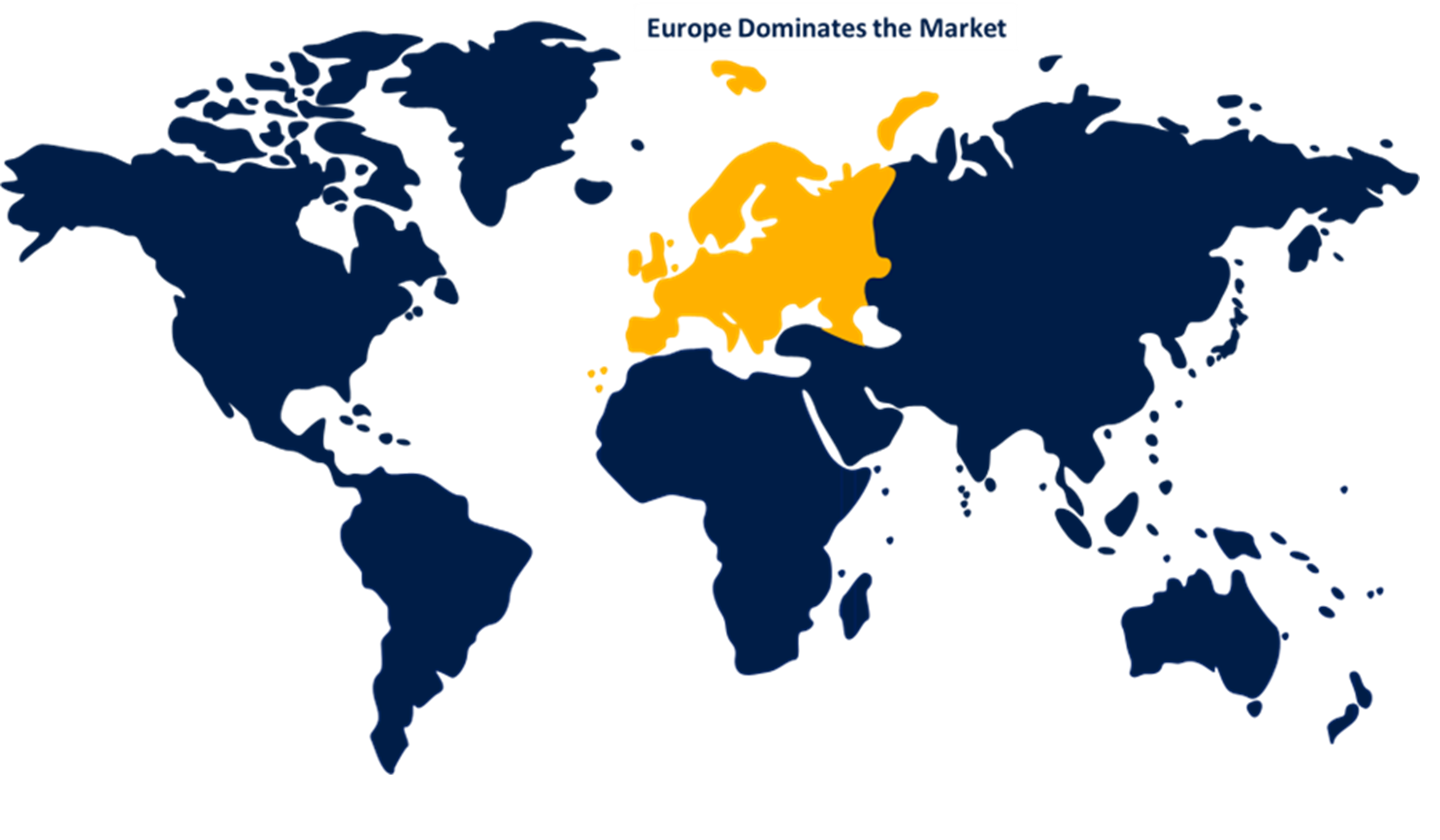Global Assistive Reproductive Technology Market Size, Share, and COVID-19 Impact Analysis, By Technology (In Vitro-fertilization (IVF), Artificial Insemination (AI-IUI), Frozen Embryo Replacement (FER), and others), End-Users (Hospital, and Fertility Clinics), and By Region (North America, Europe, Asia-Pacific, Latin America, Middle East, and Africa), Analysis and Forecast 2021 - 2030.
Industry: HealthcareGlobal Assistive Reproductive Technology Market Insights Forecasts to 2030
- The global assistive reproductive technology market was valued at USD 23.5 billion in 2021.
- The market is growing at a CAGR of 7% from 2022 to 2030
- The global assistive reproductive technology market is expected to reach USD 43.2 billion by 2030
- North America is expected to grow the fastest during the forecast period

Get more details on this report -
The global assistive reproductive technology market is expected to reach USD 43.2 billion by 2030, at a CAGR of 7% during the forecast period 2022 to 2030.
The assistive reproductive technology market has grown because the number of cases of infertility is rising due to rising stress, obesity, pollution, and changing lifestyles
Market Overview
A technique used to assist in human reproduction to cure infertility is known as assistive reproductive technology (ART). These therapies cover various methods depending on the underlying cause of infertility. It involves fertility procedures that combine the use of a man's sperm and a woman's egg. Assisted reproductive technologies don't just use pills but also methods that include both eggs and embryos.
Most ART procedures involve surgically removing eggs from a woman's ovaries (oophorectomy), fusing them with sperm in-vitro, and then returning them to the woman's body. In assisted reproductive technology (ART) operations, donor eggs, donor sperm, or already frozen embryos may be used. Additionally, It may use a gestational carrier or surrogate. A woman who conceives using the male partner of the couple's sperm is known as a surrogate. Multiple pregnancies are the most frequent side effect of assisted reproductive technology (ART). It can be avoided or reduced by restricting the number of embryos placed in a woman's body.
Some of the methods frequently used to treat such disorders include in-vitro fertilization (IVF), artificial insemination (AI-IUI), frozen embryo transfer (FET), and gamete intrafallopian transfer (GIFT). In vitro fertilization (IVF) is the most well-liked and successful kind of ART. During the forecast period, factors including increased infertility rates, increasing ART success rates, and rising disposable income in developing nations are anticipated to propel industry expansion. World Health Organization Statistics 2020 estimates that 186 million people worldwide struggle with infertility-related issues.
Numerous variables, including sexually transmitted infections (STIs), an increase in cigarette smoking, cases of obesity, endometriosis, polycystic ovary syndrome (PCOS), primary ovarian insufficiency (POC), and others, might be blamed for the rising prevalence of infertility. The demand for ART treatments is anticipated to increase as society increasingly accepts ART due to the use of more sophisticated technology, including time-lapse embryo imaging, magnetic-activated cell sorting, and preimplantation genetic testing.
For instance, the 2019 Reproductive Clinic Success Rates Report from the Centers for Disease Control and Prevention (CDC) shows that 448 fertility clinics in the U.S. performed about 330,773 ART treatments, resulting in 77,998 live births and 83,946 live-born children.
Global Assistive Reproductive Technology Market Report Coverage
| Report Coverage | Details |
|---|---|
| Base Year: | 2021 |
| Market Size in 2021: | USD 23.5 Billion |
| Forecast Period: | 2022-2030 |
| Forecast Period CAGR 2022-2030 : | 7 % |
| 2030 Value Projection: | USD 43.2 Billion |
| Historical Data for: | 2019-2020 |
| No. of Pages: | 185 |
| Tables, Charts & Figures: | 104 |
| Segments covered: | By Technology, By End User, By Region |
| Companies covered:: | Cosmos Biomedical Ltd., Microm U.K. Ltd., CooperSurgical, Inc., FUJIFILM Irvine Scientific, Cryolab Ltd., Vitrolife AB, European Sperm Bank, Bloom IVF Centre, Merck KGaA, Ferring B.V. |
| Growth Drivers: | The assistive reproductive technology market has grown because the number of cases of infertility is rising due to rising stress, obesity, pollution, and changing lifestyles. |
| Pitfalls & Challenges: | Credit portfolios have been negatively impacted by the COVID-19 outbreak. |
Get more details on this report -
Report Coverage
This research report categorizes the market for global assistive reproductive technology based on various segments and regions, forecasts revenue growth, and analyzes trends in each submarket. The report analyses the key growth drivers, opportunities, and challenges influencing the global assistive reproductive technology market.
Recent market developments and competitive strategies such as expansion, product launch and development, partnership, merger, and acquisition have been included to draw the competitive landscape in the market. The report strategically identifies and profiles the key market players and analyses their core competencies in each global assistive reproductive technology market sub-segments.
Segmentation Analysis
- In 2021, the In Vitro-fertilization (IVF) segment dominated the market with the largest market share of 40% and market revenue of 9.4 billion.
Based on the technology, the global assistive reproductive technology market is categorized into In Vitro-fertilization (IVF), Artificial Insemination (AI-IUI), Frozen Embryo Replacement (FER), and others. In 2021, the In Vitro-fertilization (IVF) segment dominated the market with the largest market share of 40% and market revenue of 9.4 billion.
The development of IVF technology, rising public awareness and government measures to control surrogacy, and expanding insurance coverage of IVF are some other significant aspects that are anticipated to have a significant impact on the development of the investigated market. As an illustration, the Indian state of Odisha established the state-assisted reproductive technologies and surrogacy board in June 2022 with the aim of regulating in vitro fertilization (IVF) clinics and outlawing commercial surrogacy.
- In 2021, the fertility clinics segment accounted for the largest share of the market, with 60% and market revenue of 14.1 billion.
Based on the end-user, the assistive reproductive technology market is categorized into Hospitals and Fertility Clinics. In 2021, the fertility clinics segment accounted for the largest share of the market, with 60% and a market revenue of 14.1 billion.
The sector is anticipated to continue growing at the fastest rate, maintaining its position as the market leader during the forecast period. The high percentage and quick expansion can be ascribed to an increase in infertility cases and the demand for a specialized setting to carry out ART.
Regional Segment Analysis of the Assistive Reproductive Technology Market
- North America (U.S., Canada, Mexico)
- Europe (Germany, France, the U.K., Italy, Spain, Rest of Europe)
- Asia-Pacific (China, Japan, India, Rest of APAC)
- South America (Brazil and the Rest of South America)
- The Middle East and Africa (UAE, South Africa, Rest of MEA)

Get more details on this report -
Europe emerged as the largest market for the global assistive reproductive technology market, with a market share of around 35.1% and 23.5 billion of the market revenue in 2021.
- In 2021, Europe emerged as the largest market for the global assistive reproductive technology market, with a market share of around 35.1% and 23.5 billion of the market revenue. During the forecast period, the sector is expected to keep expanding at the highest rate and hold the top spot in the market. An increase in infertility cases and the need for a specialized setting to perform ART can be blamed for the high percentage and rapid growth.
- For instance, the West Asian company Gulf Capitals ART Fertility Facilities declared plans to invest USD 31.3 million in the development of 18 clinics in significant Indian cities by 2023. Additional factors that are anticipated to support segment expansion throughout the forecast period are cost-effectiveness, specialization, domain knowledge, and individualized treatment.
- The North America market is expected to grow at the fastest CAGR between 2021 and 2030, Due to factors like rising infertility in the area and public organization activities that are predicted to boost market growth during the forecast period. For example, according to Statistics Canada's May 2022 report, the fertility rate in Canada decreased from 1.47 children per woman in 2019 to a record-low 1.40 children per woman in 2020. In addition, Canada experienced the fewest births since 2007. Consequently, it is anticipated that over the forecast period, demand for ART procedures will rise.
Competitive Landscape
The report offers the appropriate analysis of the key organizations/companies involved within the global assistive reproductive technology market along with a comparative evaluation primarily based on their product offering, business overviews, geographic presence, enterprise strategies, segment market share, and SWOT analysis. The report also provides an elaborative analysis focusing on the companies' current news and developments, including product development, innovations, joint ventures, partnerships, mergers & acquisitions, strategic alliances, and others. This allows for the evaluation of the overall competition within the market.
List of Key Market Players:
- Cosmos Biomedical Ltd.
- Microm U.K. Ltd.
- CooperSurgical, Inc.
- FUJIFILM Irvine Scientific
- Cryolab Ltd.
- Vitrolife AB
- European Sperm Bank
- Bloom IVF Centre
- Merck KGaA
- Ferring B.V.
Key Target Audience
- Market Players
- Investors
- End-users
- Government Authorities
- Consulting And Research Firm
- Venture capitalists
- Third-party knowledge providers
- Value-Added Resellers (VARs)
Some of the Key Developments:
- In June 2022, Inception Fertility expanded its ecosystem with the introduction of HavenCryo, a long-term reproductive tissue and cryopreservation storage solution that provides fertility specialists and patients with a distinctive experience. It consists of equipment for assisted reproduction (ART).
- In March 2022, CK Birla Healthcare opened its premier assisted reproductive technology clinic, in New Delhi.
Market Segment
This study forecasts global, regional, and country revenue from 2019 to 2030. Spherical Insights has segmented the global assistive reproductive technology market based on the below-mentioned segments:
Global Assistive Reproductive Technology Market, By Technology
- In Vitro-fertilization (IVF)
- Artificial Insemination (AI-IUI)
- Frozen Embryo Replacement (FER)
- others
Global Assistive Reproductive Technology Market, By End-Users
- Hospital
- Fertility Clinics
Global Assistive Reproductive Technology Market, Regional Analysis
- North America
- US
- Canada
- Mexico
- Europe
- Germany
- Uk
- France
- Italy
- Spain
- Russia
- Rest of Europe
- Asia Pacific
- China
- Japan
- India
- South Korea
- Australia
- Rest of Asia Pacific
- South America
- Brazil
- Argentina
- Rest of South America
- Middle East & Africa
- UAE
- Saudi Arabia
- Qatar
- South Africa
- Rest of the Middle East & Africa
Need help to buy this report?